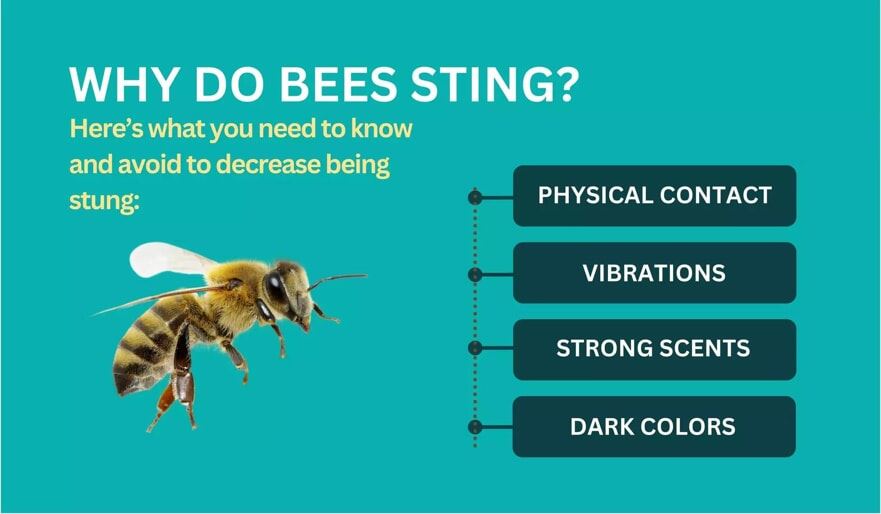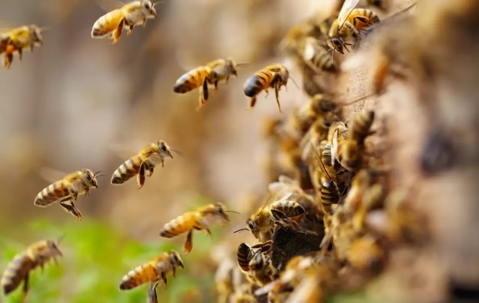Do All Bees Sting in South Florida? Here’s What to Know
Florida's buzzing with bees, but not all of them will sting you.
Wondering which bees to watch out for? Dive in to keep your outdoor fun in the Sunshine State sting-free and full of smiles.
Key Takeaways
- Bees sting primarily to defend their hive, offspring, and resources from perceived threats, including physical contact, vibrations, strong scents, and dark colors.
- Not all bees have the same inclination to sting; queen bees can sting multiple times, worker bees die after stinging, and male bees cannot sting at all.
- Bee infestations pose safety hazards, property damage, and legal concerns, with signs including increased bee activity, structures resembling hives, and finding dead bees.
- To prevent bee stings, wear appropriate clothing, avoid strong scents, remain calm, and consider professional pest control services to ensure the safe removal and prevention of future issues.
Why Do Bees Sting?

Bees are remarkable for their role in pollination and honey production, but they also possess a less celebrated feature: their sting. The primary purpose of a bee's stinger is defense.
With this natural weapon, they protect their hives, offspring, and resources from perceived threats.
Recognizing what provokes a bee to sting can help avoid painful encounters. Here’s what you need to know and avoid to decrease being stung:
- Physical Contact: Even unintentional brushing against a bee or its hive can be perceived as a threat, prompting a defensive response.
- Vibrations: The noise and vibrations from machinery, such as lawnmowers or trimmers, incredibly close to hives, can agitate bees.
- Strong Scents: Bees are sensitive to odors. Perfumes, colognes, or other strong scents can attract or provoke bees, remarkably if they resemble their pheromones.
- Dark Colors: Bees may see dark clothing as a threat, mistaking it for their natural predators, such as bears.
Common Stinging and Non-Stinging Bee Species in Florida
Florida is home to various species of bees, ranging from native social bees to solitary non-native types.
Here's a comparison chart:
Species | Native or Non-native | Social or Solitary | Coloring | Sting Capabilities |
Honey Bees (Apis mellifera) | Non-native bees; European | Social Bees | Golden-brown | Can sting |
Bumble Bees (Bombus spp.) | Native Bees | Social Bees | Black and yellow | Rarely sting |
(Xylocopa spp.) | Native Bees | Solitary Bees | Shiny black | Can sting |
(Apis mellifera scutellata) | Hybrid Bees | Social Bees | Golden-brown | Highly defensive |
Risks of Bee Infestations
While bees are crucial pollinators, their nests can pose various risks when situated close to human activity, such as:
Safety Hazards
Bees' painful stings can be dangerous, especially to those who experience symptoms like an allergic reaction or who are prone to anaphylaxis shock.
At a higher dose relative to your pound of body weight, they can be life-threatening and would require medical attention.
Property Damage
Bee colonies can cause structural damage by building within eaves and walls or burrowing into wood.
Legal Concerns
Often, removing bees requires professional pest control services, as improper handling can result in legal trouble.
Always consider contacting a licensed beekeeper or a pest control specialist who can offer a free quote and ensure a pest-free resolution.
Signs of a Bee Infestation
In North America, bee infestations can be startling for homeowners like you. This situation often highlights the need for prompt inspection and action.
Detecting a bee infestation as soon as possible can save you from more severe problems. Key signs to watch for include:
How to Prevent Bee Stings
Taking steps to avoid bee or wasp stings is essential, especially in areas with high bee activity.
Here’s how you can take action to reduce the risk:
- Wear appropriate clothing.
- Avoid strong scents.
- Remain calm.
- Be cautious with food and drinks.
- Maintain your space.
- Seal all entry points.
- Implement strategic landscaping.
- Use professional help for removal.
When to Call a Professional
In sunny Florida, bees buzz around doing their important pollinator work, but sometimes they end up where they're not wanted.
When this happens, pest control professionals (like us, Native Pest Management) have the right gear and know-how. We can relocate bees harmlessly, keeping both humans and bees safe and sound.
Without harming the environment or the bees themselves, here’s what to expect from professionals:
Service | Description |
Inspection | A thorough examination to assess the extent of the problem. |
Identification | Determining the species and the best course of action. |
Removal | Utilizing safe methods to remove the bees or hives from nesting sites. |
Prevention | Offering advice or services to prevent future issues. |
So, if and when you do need to deal with unwelcome winged visitors, it's best to do it with a bit of love and a phone call to those who know bees like the back of their hand. Bee safe, folks!
